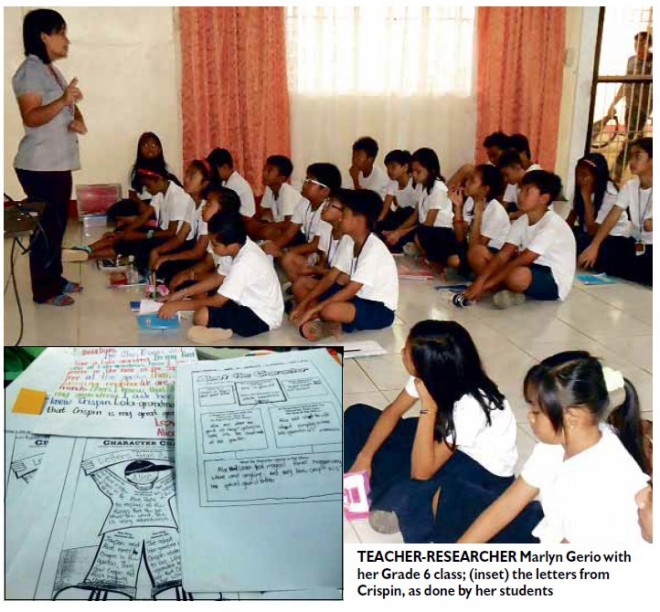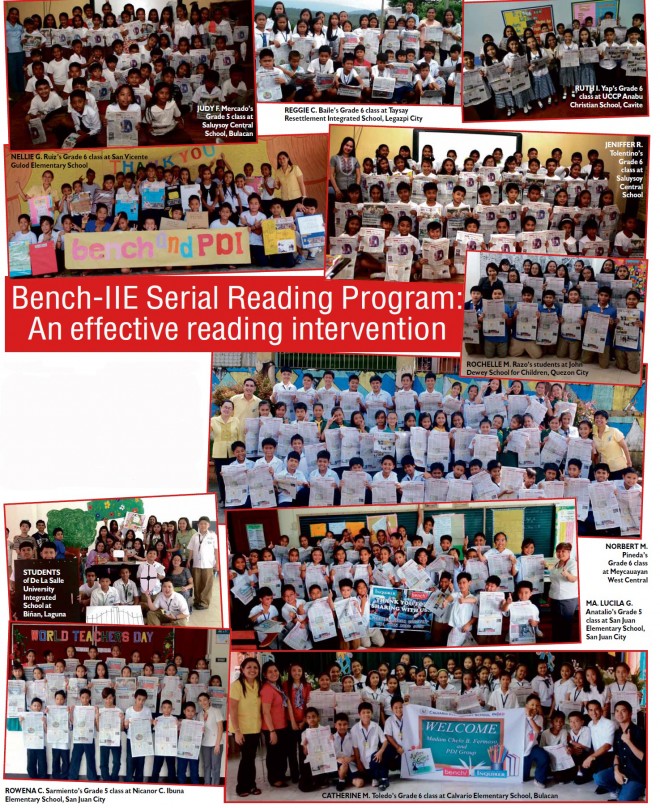Bench-IIE Serial Reading Program: An effective reading intervention
For Marlyn Gerio and her sixth grade (section Mercury) English language students, the Bench-sponsored Serial Reading Program (SRP) has become more than just another class exercise.
Under the Inquirer in Education (IIE) literacy project, which started in school year 2008-2009, selected language classes at partner elementary schools get free newspaper copies donated by Bench every Tuesday until the serialized story ends. Each new chapter is taught by partner-teachers within the week that it appears in the newspaper.
Gerio, who recently became an education program supervisor, has been an IIE partner-teacher since 2010.
Having observed that her 2013-14 class at Cataning Elementary School in Balanga, Bataan province, was composed of passive learners hardly able to express their ideas during discussion, she decided to conduct an action research “to find out if the program (SRP) could increase her pupils’ reading interest and if it would be helpful to develop their self-esteem through direct immersion in varied reading interactive activities [designed to give them] a chance to be transformed by the text that they read.”
Gerio called her research “The Effectiveness of the Conduct of the Inquirer in Education Program to the Grade VI Pupils of Cataning Elementary School.”
After doing a preseries assessment of her students’ reading attitudes, she used the succeeding six weeks, during which Cyan Abad-Jugo’s “Letters from Crispin” was serialized, for the full conduct of the study—accomplishing observation checklists, recording what she considered were “significant experiences and manifestations of learning” among the children in her class, collecting creative output, noting down the participation rate for each teaching encounter.
In her study, Gerio sought answers to three main questions: Is the IIE program effective in increasing student participation? Does it help in alleviating illiteracy in the class? What are the predominant reactions of pupils to this program?
Preseries passivity
Before she used the “Crispin” story in her class, Gerio described her 27 male and 20 female students as “very passive [and] could hardly express themselves. They were reluctant to speak in English, even scared, and their learning motivation was low.” According to the survey, 89 percent of the class did not want to read.
Gerio took into account these preseries findings in preparing lesson plans for each chapter of “Crispin” and designed activities to help the children understand the story.
Using Directed Reading Thinking Activity (DRTA) to tap the full potential of each learner through differentiated activities, she divided the class into nine groups, with each member doing a specific task for his/her group: word finder,
illustrator, discussion director, story connector and summarizer.
With the story of young Alice and Crispin as takeoff point, Gerio said the students adapted to the tasks assigned to them and the activities given. No one showed any reluctance in doing their activities. She said everyone exerted a lot of effort to make their group output good, if not the best.
The unique tasks in each group boosted the students’ confidence and made them feel special, she said.
DRTA was designed to monitor how well the children had understood the story, as well as allow students to cooperate with one another in performing their specific tasks within a given time. The teacher-researcher also used Literature Circle to monitor comprehension and to maximize student participation.
Higher self-esteem
Gerio, who said she simply facilitated the activities, noted that the students showed positive responses as they immersed themselves in the group-learning process.
She found this a validation of what Monique DeVane, head of College Preparatory School in California, said: “Group discussions empower students through collaborative thinking and learning.”
Gerio said the children gradually improved in their class performance. “As the series progressed, they manifested maximum participation and ardent interest in their roles in the group. They became articulate … their confidence level increased and their inhibitions [disappeared].
The survey revealed that interest in reading significantly increased as they found the story enjoyable to read in a newspaper instead of a textbook. The students were excited to get their copies of the Inquirer every week to read the next chapter of “Letters from Crispin”—anticipating, even predicting, what would happen next.
Gerio said that as the children’s interest in reading grew, the participation rate also increased over time—from 50 percent in the second week to 97.87 percent by the time the last installment of the story was read and taken up in class.
Passivity was reduced and the pupils became more engaged, their active involvement in class leading to improvement in performance. They were encouraged to write about what they had read.
Creative outputs improved tremendously over the same period—from simply good to “stupendous,” by Gerio’s own assessment.
Comprehension and retention of what they read also appeared to increase significantly. The students were able not only to retell the story but also to name the various characters and empathize with particular characters.
The retelling session, where the students had to respond to her assessment checklist, helped to facilitate learning and check comprehension so that she would recommend its use in all reading classes.
Improved attendance
Individual comments on “Crispin” revealed just how much the students became caught up in the serialized story:
“‘Letters from Crispin’ is very engaging and exciting.”
“I enjoyed reading the serialized story … it made the class wait for another week to know what would happen to the characters in the story.”
“It actually improved our attendance because we didn’t want to miss our class on Wednesdays.” (The chapters appeared in the Inquirer Learning section on Tuesday and were discussed in participating classes the following day.)
“I liked the different roles we assumed in our group.”
“I liked it most when we had to draw our most important event and [write] our reason for choosing it and the part where we prepared our summary and all of the members would have to write a sentence to form our summary.”
“I enjoyed the activities and I understood the story easily.”
“I am a different pupil now upon completion of the series.”
“I like Chapter 3, [which is about] the haunted house.”
“My interest in reading now is 10 on a scale of 1-10. It was so low before the series.”
“I am recommending this program to the next Grade 6 class … it is something you can look forward to.”
Conclusion
Gerio said the study made her realize that her students’ initial lack of interest in reading and speaking in English arose from lack of motivation, deficient reading and communication skills and poor comprehension.
She found the use of serialized reading stories like “Letters from Crispin” helpful in kindling the interest in reading of her pupils and getting them used to reading to improve vocabulary and communication skills.
Gerio concluded from her study “that the IIE program is very effective in [encouraging] pupils to be creative, articulate and active” learners. She would recommend it to other intermediate grade English language teachers, along with the use of DRTA and Literature Circle in teaching reading, monitoring comprehension and maximizing student participation.
Although Gerio referred to her study as an action research, she said her supervisor considered it an innovation as well. She is thankful to Schools Division Superintendent officer in charge Dr. Ronaldo A. Pozon, Public Schools District Supervisor (District II) Jeanette L. Andales and principal Amelia T. Inieto for their support and permission to undertake the study. Gerio brought along the Bench-IIE SRP as an English-reading program upon her transfer to Cataning in 2011 from another school in Balanga.
Through her action research, she said, she had hoped to prove that certain programs improved the performance and attitude of students.
“‘Letters from Crispin’ is a story that made a positive difference for my class,” she said.


